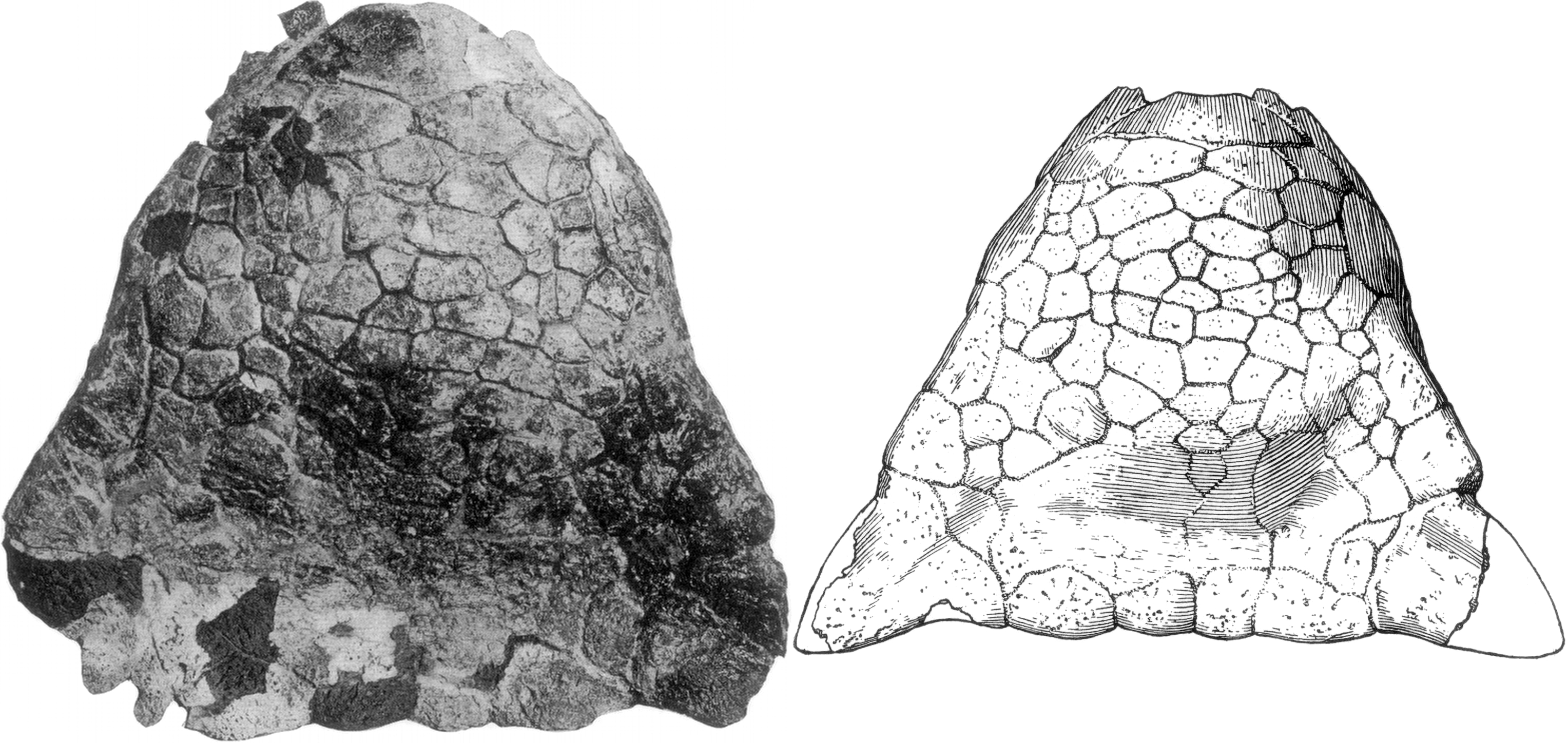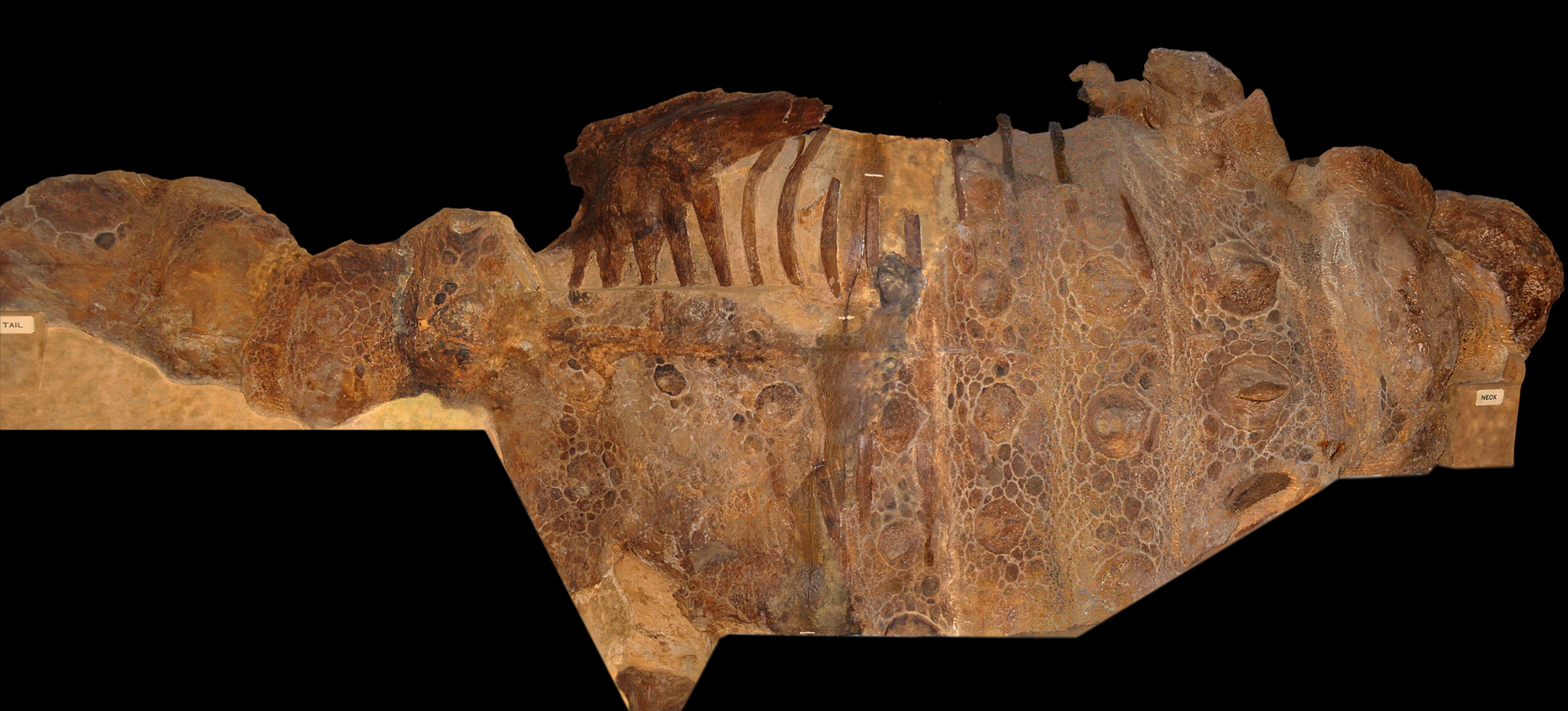|
Ankylosaurids
Ankylosauridae () is a family of armored dinosaurs within Ankylosauria, and is the sister group to Nodosauridae. The oldest known ankylosaurids date to around 122 million years ago and went extinct 66 million years ago during the Cretaceous–Paleogene extinction event. These animals were mainly herbivorous and were obligate quadrupeds, with leaf-shaped teeth and robust, scute-covered bodies. Ankylosaurids possess a distinctly domed and short snout, wedge-shaped osteoderms on their skull, scutes along their torso, and a tail club. Ankylosauridae is exclusively known from the Northern Hemisphere, with specimens found in North America, Europe, and Asia. The first discoveries within this family were of the genus ''Ankylosaurus'', by Peter Kaiser and Barnum Brown in Montana in 1906. Brown went on to name Ankylosauridae and the subfamily Ankylosaurinae in 1908. Anatomy Ankylosaurids are stout, solidly built, armoured dinosaurs. They possess accessory ossifications on cranial bones ... [...More Info...] [...Related Items...] OR: [Wikipedia] [Google] [Baidu] |
Ankylosaurus Magniventris
''Ankylosaurus'' is a genus of armored dinosaur. Its fossils have been found in geological formations dating to the very end of the Cretaceous Period, about 68–66 million years ago, in western North America, making it among the last of the non-avian dinosaurs. It was named by Barnum Brown in 1908; it is monotypic, containing only ''A. magniventris''. The generic name means "fused" or "bent lizard", and the specific name means "great belly". A handful of specimens have been excavated to date, but a complete skeleton has not been discovered. Though other members of Ankylosauria are represented by more extensive fossil material, ''Ankylosaurus'' is often considered the archetypal member of its group, despite having some unusual features. Possibly the largest known ankylosaurid, ''Ankylosaurus'' is estimated to have been between long and to have weighed between . It was quadrupedal, with a broad, robust body. It had a wide, low skull, with two horns pointing backward from th ... [...More Info...] [...Related Items...] OR: [Wikipedia] [Google] [Baidu] |
Ankylosaurus Tail Terminology
''Ankylosaurus'' is a genus of Thyreophora, armored dinosaur. Its fossils have been found in geological formations dating to the very end of the Cretaceous Period (geology), Period, about 68–66 million years ago, in western North America, making it among the last of the non-avian dinosaurs. It was named by Barnum Brown in 1908; it is Monotypic taxon, monotypic, containing only ''A. magniventris''. The Binomial nomenclature, generic name means "fused" or "bent lizard", and the specific name means "great belly". A handful of specimens have been excavated to date, but a complete skeleton has not been discovered. Though other members of Ankylosauria are represented by more extensive fossil material, ''Ankylosaurus'' is often considered the archetype, archetypal member of its group, despite having some unusual features. Possibly the largest known Ankylosauridae, ankylosaurid, ''Ankylosaurus'' is estimated to have been between long and to have weighed between . It was Quadrupedal ... [...More Info...] [...Related Items...] OR: [Wikipedia] [Google] [Baidu] |
Scolosaurus Thronus
''Scolosaurus'' is an extinct genus of ankylosaurid dinosaurs within the subfamily Ankylosaurinae. It is known from the lower levels of the Dinosaur Park Formation and upper levels of the Oldman Formation in the Late Cretaceous (latest middle Campanian stage, about 76.5 Ma ago) of Alberta, Canada. It contains two species, ''S. cutleri'' and ''S. thronus''. The type species, ''S. cutleri'', measured up to in length and in body mass. Discovery ''Scolosaurus'' was named by Franz Nopcsa von Felső-Szilvás in 1928, based on holotype NHMUK PV R.5161, a nearly complete specimen that preserves the entire skeleton except for the distal end of the tail, the right forelimb, the right hindlimb, and the skull. The rare preservation of osteoderms and skin impression are also present. The fossil skeleton was discovered by William Edmund Cutler, an independent fossil collector in 1914 at Quarry 80 of the Deadlodge Canyon locality. It was collected from the bottom of the Dinosaur Park ... [...More Info...] [...Related Items...] OR: [Wikipedia] [Google] [Baidu] |
Ankylosaurinae
Ankylosaurinae is a subfamily of ankylosaurid dinosaurs, existing from the Early Cretaceous about 105 million years ago until the end of the Late Cretaceous, about 66 mya. Many genera are included in the clade, such as '' Ankylosaurus'', ''Pinacosaurus'', '' Euoplocephalus'', and '' Saichania''. Features Ankylosaurinae is formally defined in the ''PhyloCode'' as "the largest clade containing '' Ankylosaurus magniventris'', but not '' Shamosaurus scutatus''". The tribe Ankylosaurini is defined in the ''PhyloCode'' as "the largest clade containing '' Ankylosaurus magniventris'', but not '' Pinacosaurus grangeri'' and '' Saichania chulsanensis''". Diagnostic features of ankylosaurines include the nuchal shelf that obscures the occiput in dorsal view, and the quadrate condyle which is obscured lightly by the quadratojugal boss. Phylogeny The following cladogram is based on the 50% majority rule phylogenetic analysis In biology, phylogenetics () is the study of the evoluti ... [...More Info...] [...Related Items...] OR: [Wikipedia] [Google] [Baidu] |
Skull Of Ankylosaurus
The skull, or cranium, is typically a bony enclosure around the brain of a vertebrate. In some fish, and amphibians, the skull is of cartilage. The skull is at the head end of the vertebrate. In the human, the skull comprises two prominent parts: the neurocranium and the facial skeleton, which evolved from the first pharyngeal arch. The skull forms the frontmost portion of the axial skeleton and is a product of cephalization and vesicular enlargement of the brain, with several special senses structures such as the eyes, ears, nose, tongue and, in fish, specialized tactile organs such as barbels near the mouth. The skull is composed of three types of bone: cranial bones, facial bones and ossicles, which is made up of a number of fused flat and irregular bones. The cranial bones are joined at firm fibrous junctions called sutures and contains many foramina, fossae, processes, and sinuses. In zoology, the openings in the skull are called fenestrae, the most prominent of ... [...More Info...] [...Related Items...] OR: [Wikipedia] [Google] [Baidu] |
Ghostbusters
''Ghostbusters'' is a 1984 American supernatural comedy film directed by Ivan Reitman and written by Dan Aykroyd and Harold Ramis. It stars Bill Murray, Aykroyd, and Ramis as Peter Venkman, Ray Stantz, and Egon Spengler, three eccentric parapsychologists who start a ghost-catching business in New York City. It also stars Sigourney Weaver and Rick Moranis, and features Annie Potts, Ernie Hudson, and William Atherton in supporting roles. Based on his fascination with spirituality, Aykroyd conceived ''Ghostbusters'' as a project starring himself and John Belushi, in which they would venture through time and space battling supernatural threats. Following Belushi's death in 1982, and with Aykroyd's concept deemed financially impractical, Ramis was hired to help rewrite the script to set it in New York City and make it more realistic. It was the first comedy film to employ expensive special effects, and Columbia Pictures, concerned about its relatively high $25–30 mi ... [...More Info...] [...Related Items...] OR: [Wikipedia] [Google] [Baidu] |
Zuul
''Zuul'' is a genus of herbivorous ankylosaurine dinosaur from the Campanian Judith River Formation of Montana. The type species is ''Zuul crurivastator''. It is known from a complete skull and tail, which represents the first ankylosaurin known from a complete skull and tail club, as well as the most complete ankylosaurid specimen thus far recovered from North America. The specimen also preserved ''in situ'' osteoderms, keratin, and skin remains. Discovery and naming In 2014, Theropoda Expeditions LLC was excavating a possible ''Gorgosaurus'' specimen near Havre, Montana. On 16 May, a skid-steer loader removing a -high overburden unexpectedly hit upon an ankylosaurian tail club. An almost complete ankylosaur skeleton proved to be present. As it had not been eroded on the surface, it was in pristine condition. It was found overturned, with the stomach facing upwards. The skeleton was largely articulated, but the skull and some neck vertebrae were separated from the main torso ... [...More Info...] [...Related Items...] OR: [Wikipedia] [Google] [Baidu] |
Vertebra
Each vertebra (: vertebrae) is an irregular bone with a complex structure composed of bone and some hyaline cartilage, that make up the vertebral column or spine, of vertebrates. The proportions of the vertebrae differ according to their spinal segment and the particular species. The basic configuration of a vertebra varies; the vertebral body (also ''centrum'') is of bone and bears the load of the vertebral column. The upper and lower surfaces of the vertebra body give attachment to the intervertebral discs. The posterior part of a vertebra forms a vertebral arch, in eleven parts, consisting of two pedicles (pedicle of vertebral arch), two laminae, and seven processes. The laminae give attachment to the ligamenta flava (ligaments of the spine). There are vertebral notches formed from the shape of the pedicles, which form the intervertebral foramina when the vertebrae articulate. These foramina are the entry and exit conduits for the spinal nerves. The body of the vertebr ... [...More Info...] [...Related Items...] OR: [Wikipedia] [Google] [Baidu] |
Tail Club
In zoology, a tail club is a bony mass at the end of the tail of some dinosaurs and of some mammals, most notably the Ankylosauridae, ankylosaurids and the glyptodonts, as well as meiolaniid turtles. It is thought that this was a form of defensive Armour (zoology), armour or weapon that was used to defend against predators, much in the same way as a thagomizer, possessed by stegosaurids, though at least in glyptodonts it is hypothesized it was used in Display (zoology), fighting for mating rights. Among dinosaurs, the club was present mainly in ankylosaurids, although Sauropoda, sauropods like ''Shunosaurus'' and ''Kotasaurus'' also possessed a tail club. Victoria Arbour has established that ankylosaurid tails could generate enough force to break bone during impacts. In a separate study, Arbour suggested tail clubs as well as large armoured herbivores as a whole evolve when animals are too large to hide and too small to avoid predation by size alone. Morphology In ankylosaurid di ... [...More Info...] [...Related Items...] OR: [Wikipedia] [Google] [Baidu] |
Ossicles
The ossicles (also called auditory ossicles) are three irregular bones in the middle ear of humans and other mammals, and are among the smallest bones in the human body. Although the term "ossicle" literally means "tiny bone" (from Latin ''ossiculum'') and may refer to any small bone throughout the body, it typically refers specifically to the malleus, incus and stapes ("hammer, anvil, and stirrup") of the middle ear. The auditory ossicles serve as a kinematic chain to transmit and amplify ( intensify) sound vibrations collected from the air by the ear drum to the fluid-filled labyrinth ( cochlea). The absence or pathology of the auditory ossicles would constitute a moderate-to-severe conductive hearing loss. Structure The ossicles are, in order from the eardrum to the inner ear (from superficial to deep): the malleus, incus, and stapes, terms that in Latin are translated as "the hammer, anvil, and stirrup". * The malleus () articulates with the incus through the ... [...More Info...] [...Related Items...] OR: [Wikipedia] [Google] [Baidu] |
Osteoderm
Osteoderms are bony deposits forming scales, plates, or other structures based in the dermis. Osteoderms are found in many groups of extant and extinct reptiles and amphibians, including lizards, crocodilians, frogs, temnospondyls (extinct amphibians), various groups of dinosaurs (most notably ankylosaurs and stegosaurians), phytosaurs, aetosaurs, placodonts, and hupehsuchians (marine reptiles with possible ichthyosaur affinities). Osteoderms are uncommon in mammals, although they have occurred in many xenarthrans (armadillos and the extinct glyptodonts and mylodontid ground sloths). The heavy, bony osteoderms have evolved independently in many different lineages. The armadillo osteoderm is believed to develop in subcutaneous dermal tissues. These varied structures should be thought of as anatomical analogues, not homologues, and do not necessarily indicate monophyly. The structures are however derived from scutes, common to all classes of amniotes and are an exampl ... [...More Info...] [...Related Items...] OR: [Wikipedia] [Google] [Baidu] |







